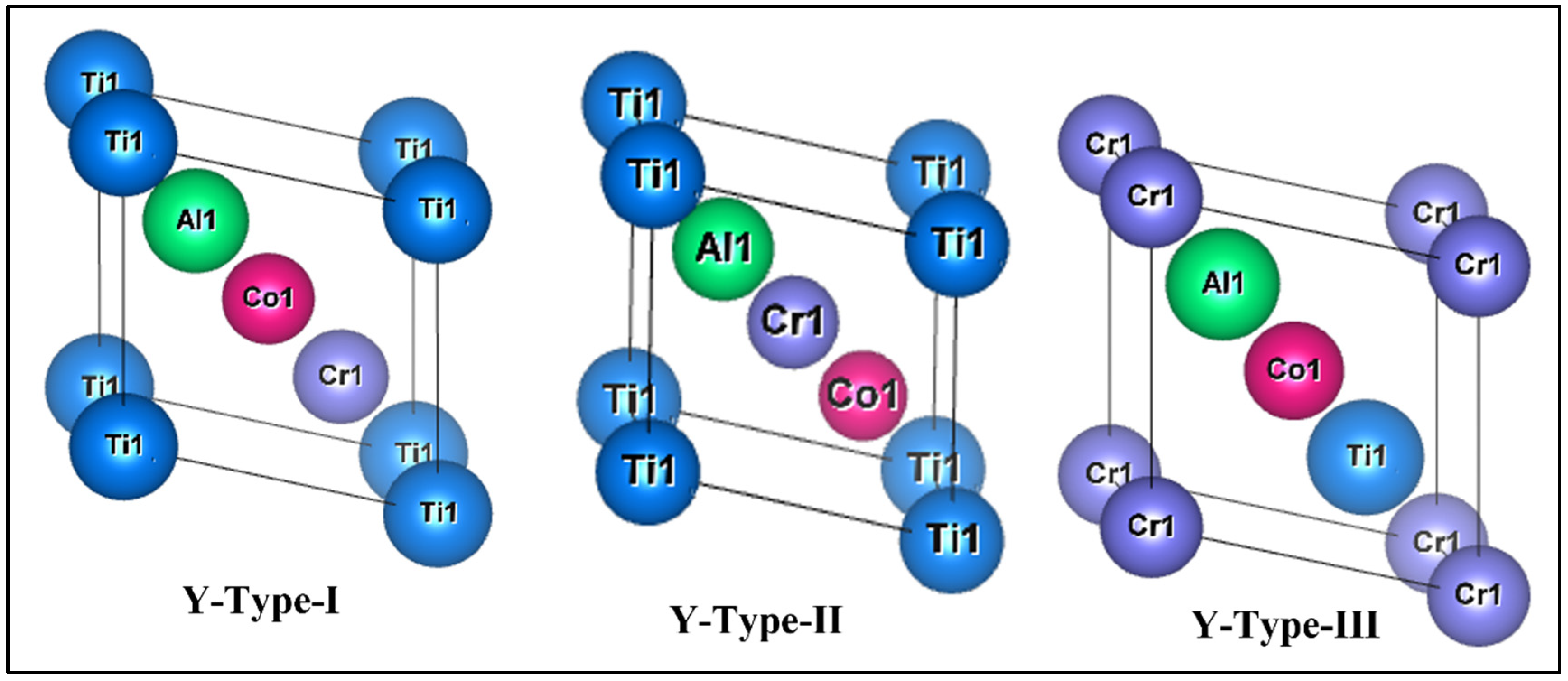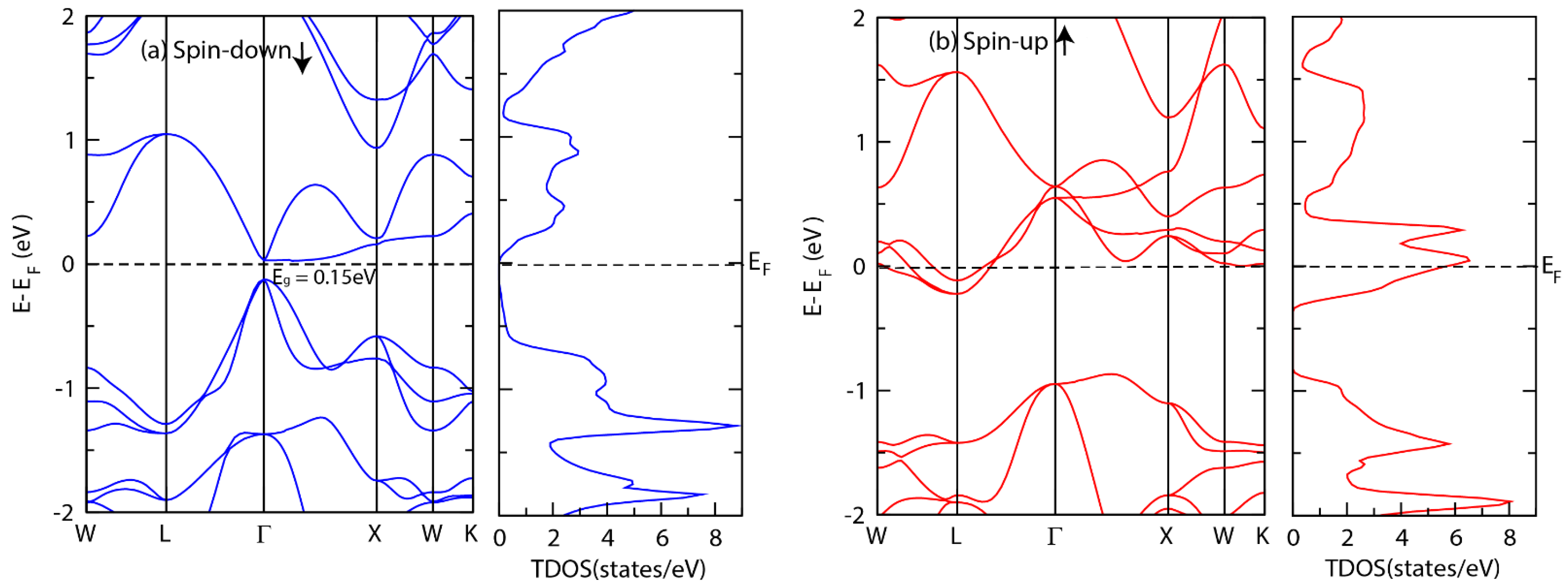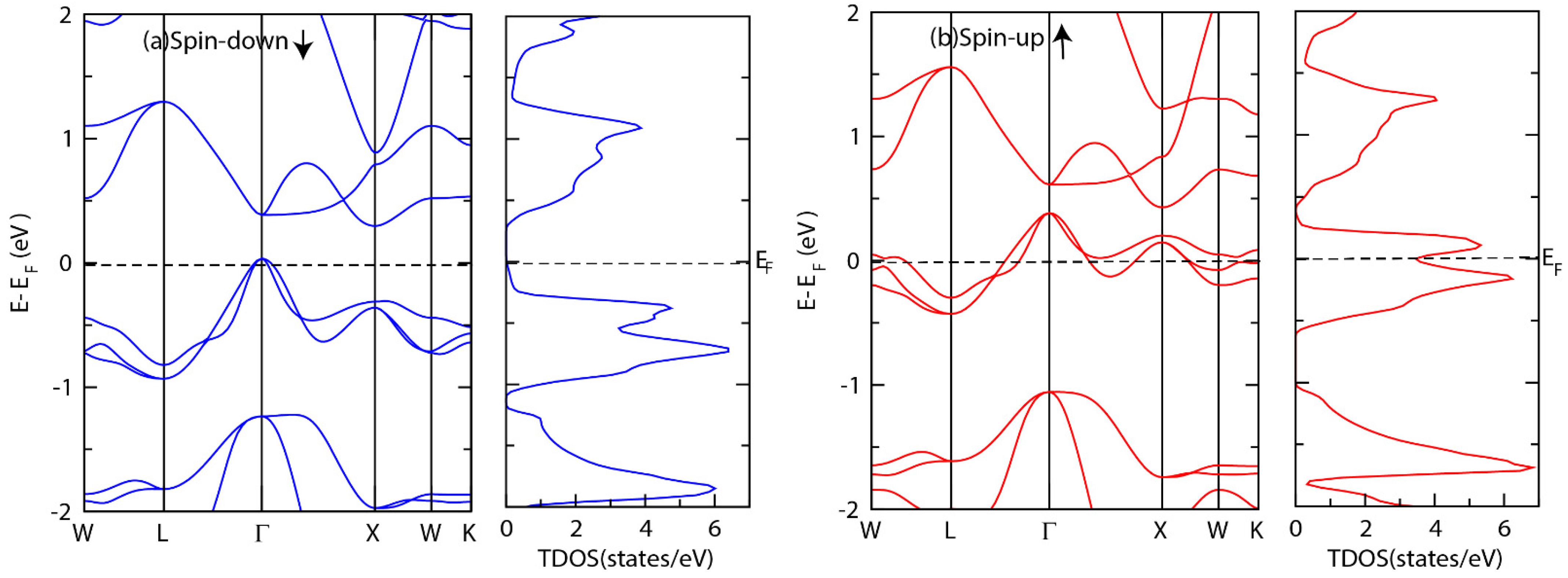Lattice Dynamics, Mechanical Properties, Electronic Structure and Magnetic Properties of Equiatomic Quaternary Heusler Alloys CrTiCoZ (Z = Al, Si) Using First Principles Calculations
Abstract
:1. Introduction
2. Computational Methods
3. Results and Discussion
3.1. Structural, Dynamical and Mechanical Properties
3.2. Electronic and Magnetic Properties
4. Conclusions
Author Contributions
Funding
Conflicts of Interest
References
- Hirohata, A.; Yamada, K.; Nakatani, Y.; Prejbeanu, I.-L.; Diény, B.; Pirro, P.; Hillebrands, B. Review on spintronics: Principles and device applications. J. Magn. Magn. Mater. 2020, 509, 166711. [Google Scholar] [CrossRef]
- Peng, S.; Zhang, Y.; Wang, M.; Zhao, W. Magnetic Tunnel Junctions for Spintronics: Principles and Applications. In Wiley Encyclopedia of Electrical and Electronics Engineering; Wiley: Hoboken, NJ, USA, 2014; pp. 1–16. [Google Scholar] [CrossRef] [Green Version]
- Julliere, M. Tunneling between ferromagnetic films. Phys. Lett. A 1975, 54, 225–226. [Google Scholar] [CrossRef]
- Erkisi, A.; Yildiz, B.; Wang, X.; Isik, M.; Ozcan, Y.; Surucu, G. The investigation of electronic nature and mechanical properties under spin effects for new half-metallic ferromagnetic chalcogenides Ag3CrX4 (X=S, Se, and Te). J. Magn. Magn. Mater. 2020, 519, 167482. [Google Scholar] [CrossRef]
- Erkisi, A.; Surucu, G. The electronic and elasticity properties of new half-metallic chalcogenides Cu3TMCh4 (TM = Cr, Fe and Ch = S, Se, Te): An ab initio study. Philos. Mag. 2018, 99, 513–529. [Google Scholar] [CrossRef]
- Coey, J.M.D.; Venkatesan, M. Half-metallic ferromagnetism: Example of CrO2 (invited). J. Appl. Phys. 2002, 91, 8345. [Google Scholar] [CrossRef]
- Dedkov, Y.S.; Rüdiger, U.; Güntherodt, G. Evidence for the half-metallic ferromagnetic state of Fe3O4by spin-resolved photoelectron spectroscopy. Phys. Rev. B 2002, 65, 064417. [Google Scholar] [CrossRef] [Green Version]
- Bouadjemi, B.; Bentata, S.; Abbad, A.; Benstaali, W.; Bouhafs, B. Half-metallic ferromagnetism in PrMnO3 perovskite from first principles calculations. Solid State Commun. 2013, 168, 6–10. [Google Scholar] [CrossRef]
- Abbad, A.; Benstaali, W.; Bentounes, H.; Bentata, S.; Benmalem, Y. Search for half-metallic ferromagnetism in orthorhombic Ce(Fe/Cr)O3 perovskites. Solid State Commun. 2016, 228, 36–42. [Google Scholar] [CrossRef]
- Block, T.; Carey, M.J.; Gurney, B.A.; Jepsen, O. Band-structure calculations of the half-metallic ferromagnetism and structural stability of full- and half-Heusler phases. Phys. Rev. B 2004, 70, 205114. [Google Scholar] [CrossRef]
- Mitani, S. Magnetic tunnel junctions using heusler alloys. In Heusler Alloys: Properties, Growth, Applications; Felser, C., Hirohata, A., Eds.; Springer International Publishing: Cham, Switzerland, 2016; pp. 401–412. [Google Scholar]
- Ghimire, M.; Sandeep; Sinha, T.; Thapa, R. First principles study of the electronic and magnetic properties of semi-Heusler alloys NiXSb (X=Ti, V, Cr and Mn). J. Alloys Compd. 2011, 509, 9742–9752. [Google Scholar] [CrossRef]
- Hordequin, C.; Nozières, J.; Pierre, J. Half metallic NiMnSb-based spin-valve structures. J. Magn. Magn. Mater. 1998, 183, 225–231. [Google Scholar] [CrossRef]
- Hordequin, C.; Ristoiu, D.; Ranno, L.; Pierre, J. On the cross-over from half-metal to normal ferromagnet in NiMnSb. Eur. Phys. J. B 2000, 16, 287–293. [Google Scholar] [CrossRef]
- Pierre, J.; Skolozdra, R.; Tobola, J.; Kaprzyk, S.; Hordequin, C.; Kouacou, M.; Karla, I.; Currat, R.; Lelièvre-Berna, E. Properties on request in semi-Heusler phases. J. Alloys Compd. 1997, 262–263, 101–107. [Google Scholar] [CrossRef]
- Tobola, J.; Pierre, J.; Kaprzyk, S.; Skolozdra, R.V.; Kouacou, M.A. Crossover from semiconductor to magnetic metal in semi-Heusler phases as a function of valence electron concentration. J. Physics: Condens. Matter 1998, 10, 1013–1032. [Google Scholar] [CrossRef]
- Amudhavalli, A.; Rajeswarapalanichamy, R.; Iyakutti, K. Half metallic ferromagnetism in Ni based half Heusler alloys. Comput. Mater. Sci. 2018, 148, 87–103. [Google Scholar] [CrossRef]
- Iyorzor, B.; Babalola, M. Half-metallic Characteristics of the Novel Half Heusler Alloys XCrSb (X=Ti, Zr, Hf). J. Niger. Soc. Phys. Sci. 2022, 4, 138–145. [Google Scholar] [CrossRef]
- Mehmood, N.; Ahmad, R. Structural, Electronic, Magnetic, and Optical Properties of Half-Heusler Alloys RuMnZ (Z=P, As): A First-Principle Study. J. Supercond. Nov. Magn. 2017, 31, 233–239. [Google Scholar] [CrossRef]
- Beldi, L.; Zaoui, Y.; Obodo, K.; Bendaoud, H.; Bouhafs, B. d0 Half-Metallic Ferromagnetism in GeNaZ (Z=Ca, Sr, and Ba) Ternary Half-Heusler Alloys: An Ab initio Investigation. J. Supercond. Nov. Magn. 2020, 33, 3121–3132. [Google Scholar] [CrossRef]
- Sefir, Y.; Terkhi, S.; Zitouni, Z.; Siad, A.B.; Seddik, T.; Benani, M.A.; Lantri, T.; Bentata, S. Structural, electronic, magnetic and thermodynamic properties of the new multifunctional half-Heusler alloy CoTcSn: Half-metallic and ferromagnetic behaviour. Pramana 2021, 95, 95. [Google Scholar] [CrossRef]
- Wurmehl, S.; Fecher, G.H.; Ksenofontov, V.; Casper, F.; Stumm, U.; Felser, C.; Lin, H.-J.; Hwu, Y. Half-metallic ferromagnetism with high magnetic moment and high Curie temperature in Co2FeSi. J. Appl. Phys. 2006, 99, 08J103. [Google Scholar] [CrossRef] [Green Version]
- Aguayo, A.; Murrieta, G. Density functional study of the half-metallic ferromagnetism in Co-based Heusler alloys Co2MSn (M=Ti, Zr, Hf) using LSDA and GGA. J. Magn. Magn. Mater. 2011, 323, 3013–3017. [Google Scholar] [CrossRef]
- Birsan, A.; Palade, P. Band structure calculations of Ti2FeSn: A new half-metallic compound. Intermet 2013, 36, 86–89. [Google Scholar] [CrossRef] [Green Version]
- Amrich, O.; Monir, M.E.A.; Baltach, H.; Bin Omran, S.; Sun, X.-W.; Wang, X.; Al-Douri, Y.; Bouhemadou, A.; Khenata, R. Half-Metallic Ferrimagnetic Characteristics of Co2YZ (Z = P, As, Sb, and Bi) New Full-Heusler Alloys: A DFT Study. J. Supercond. Nov. Magn. 2018, 31, 241–250. [Google Scholar] [CrossRef]
- Ullah, H.; Khalid, S. Exchange interactions, half metallic ferromagnetism, mechanical, thermal and magneto-electronic properties of full Heusler alloys Co2YGe(Y=Mn, Fe) for acoustical and spintronic devices. Phys. B: Condens. Matter 2021, 615, 413060. [Google Scholar] [CrossRef]
- Bainsla, L.; Suresh, K.G. Equiatomic quaternary Heusler alloys: A material perspective for spintronic applications. Appl. Phys. Rev. 2016, 3, 031101. [Google Scholar] [CrossRef] [Green Version]
- Gao, G.; Hu, L.; Yao, K.; Luo, B.; Liu, N. Large half-metallic gaps in the quaternary Heusler alloys CoFeCrZ (Z=Al, Si, Ga, Ge): A first-principles study. J. Alloys Compd. 2013, 551, 539–543. [Google Scholar] [CrossRef]
- Khan, M.I.; Arshad, H.; Rizwan, M.; Gillani, S.; Zafar, M.; Ahmed, S.; Shakil, M. Investigation of structural, electronic, magnetic and mechanical properties of a new series of equiatomic quaternary Heusler alloys CoYCrZ (Z=Si, Ge, Ga, Al): A DFT study. J. Alloy. Compd. 2020, 819, 152964. [Google Scholar] [CrossRef]
- Klaer, P.; Balke, B.; Alijani, V.; Winterlik, J.; Fecher, G.H.; Felser, C.; Elmers, H.J. Element-specific magnetic moments and spin-resolved density of states in CoFeMnZ(Z=Al, Ga; Si, Ge). Phys. Rev. B 2011, 84, 144413. [Google Scholar] [CrossRef]
- Bahnes, A.; Boukortt, A.; Abbassa, H.; Aimouch, D.; Hayn, R.; Zaoui, A. Half-metallic ferromagnets behavior of a new quaternary Heusler alloys CoFeCrZ (Z = P, As and Sb): Ab-initio study. J. Alloys Compd. 2018, 731, 1208–1213. [Google Scholar] [CrossRef]
- Benkabou, M.; Rached, H.; Abdellaoui, A.; Rached, D.; Khenata, R.; Elahmar, M.; Abidri, B.; Benkhettou, N.; Bin-Omran, S. Electronic structure and magnetic properties of quaternary Heusler alloys CoRhMnZ (Z = Al, Ga, Ge and Si) via first-principle calculations. J. Alloys Compd. 2015, 647, 276–286. [Google Scholar] [CrossRef]
- Khodami, M.; Ahmadian, F. First-Principles Study of Magnetism and Half-Metallic Properties for the Quaternary Heusler Alloys CoMnTiZ (Z=P, As, and Sb). J. Supercond. Nov. Magn. 2015, 28, 3027–3035. [Google Scholar] [CrossRef]
- Chandra, A.R.; Jain, V.; Lakshmi, N.; Jain, V.K.; Soni, K.; Jain, R. Electronic structure properties of new equiatomic CoCuMnZ (Z=In, Sn, Sb) quaternary Heusler alloys: An ab-initio study. J. Alloys Compd. 2018, 748, 298–304. [Google Scholar] [CrossRef]
- Rani, D.; Enamullah; Suresh, K.G.; Yadav, A.K.; Jha, S.N.; Bhattacharyya, D.; Varma, M.R.; Alam, A. Structural, electronic, magnetic, and transport properties of the equiatomic quaternary Heusler alloy CoRhMnGe: Theory and experiment. Phys. Rev. B 2017, 96, 184404. [Google Scholar] [CrossRef] [Green Version]
- Hoat, D. Investigation on new equiatomic quaternary Heusler compound CoCrIrSi via FP-LAPW calculations. Chem. Phys. 2019, 523, 130–137. [Google Scholar] [CrossRef]
- Bainsla, L.; Suzuki, K.Z.; Tsujikawa, M.; Tsuchiura, H.; Shirai, M.; Mizukami, S. Magnetic tunnel junctions with an equiatomic quaternary CoFeMnSi Heusler alloy electrode. Appl. Phys. Lett. 2018, 112, 052403. [Google Scholar] [CrossRef]
- Tsuchiya, T.; Roy, T.; Elphick, K.; Okabayashi, J.; Bainsla, L.; Ichinose, T.; Suzuki, K.Z.; Tsujikawa, M.; Shirai, M.; Hirohata, A.; et al. Magnetic tunnel junctions with a B2-ordered CoFeCrAl equiatomic Heusler alloy. Phys. Rev. Mater. 2019, 3, 084403. [Google Scholar] [CrossRef] [Green Version]
- Özdoğan, K.; Şaşıoğlu, E.; Galanakis, I. Slater-Pauling behavior in LiMgPdSn-type multifunctional quaternary Heusler materials: Half-metallicity, spin-gapless and magnetic semiconductors. J. Appl. Phys. 2013, 113, 193903. [Google Scholar] [CrossRef] [Green Version]
- Kresse, G.; Furthmüller, J. Efficiency of ab-initio total energy calculations for metals and semiconductors using a plane-wave basis set. Comput. Mater. Sci. 1996, 6, 15–50. [Google Scholar] [CrossRef]
- Kresse, G.; Furthmüller, J. Efficient iterative schemes forab initiototal-energy calculations using a plane-wave basis set. Phys. Rev. B 1996, 54, 11169–11186. [Google Scholar] [CrossRef]
- Blöchl, P.E. Projector augmented-wave method. Phys. Rev. B Condens. Matter Mater. Phys. 1994, 50, 17953–17979. [Google Scholar] [CrossRef] [Green Version]
- Perdew, J.P.; Burke, K.; Ernzerhof, M. Generalized gradient approximation made simple. Phys. Rev. Lett. 1996, 77, 3865. [Google Scholar] [CrossRef] [Green Version]
- Togo, A.; Tanaka, I. First principles phonon calculations in materials science. Scr. Mater. 2015, 108, 1–5. [Google Scholar] [CrossRef] [Green Version]
- Kresse, G.; Furthmüller, J.; Hafner, J. Ab initio Force Constant Approach to Phonon Dispersion Relations of Diamond and Graphite. Eur. Lett. 1995, 32, 729–734. [Google Scholar] [CrossRef]
- Parlinski, K.; Li, Z.Q.; Kawazoe, Y. First-Principles Determination of the Soft Mode in Cubic ZrO2. Phys. Rev. Lett. 1997, 78, 4063–4066. [Google Scholar] [CrossRef]
- Blaha, P.; Schwarz, K.; Tran, F.; Laskowski, R.; Madsen, G.K.H.; Marks, L.D. WIEN2k: An APW+lo program for calculating the properties of solids. J. Chem. Phys. 2020, 152, 074101. [Google Scholar] [CrossRef]
- Yu, E.; Pan, Y. Influence of noble metals on the electronic and optical properties of LiH hydride: First-principles calculations. Int. J. Hydrogen Energy 2021, 46, 35342–35350. [Google Scholar] [CrossRef]
- Pan, Y.; Chen, S. Exploring the novel structure, transportable capacity and thermodynamic properties of TiH2 hydrogen storage material. Int. J. Energy Res. 2020, 44, 4997–5007. [Google Scholar] [CrossRef]
- Born, M.; Huang, K.; Lax, M. Dynamical Theory of Crystal Lattices. Am. J. Phys. 1955, 23, 474. [Google Scholar] [CrossRef]
- Hill, R. The Elastic Behaviour of a Crystalline Aggregate. Proc. Phys. Soc. Sect. A 1952, 65, 349. [Google Scholar] [CrossRef]
- Semari, F.; Boulechfar, R.; Dahmane, F.; Abdiche, A.; Ahmed, R.; Naqib, S.; Bouhemadou, A.; Khenata, R.; Wang, X. Phase stability, mechanical, electronic and thermodynamic properties of the Ga3Sc compound: An ab-initio study. Inorg. Chem. Commun. 2020, 122, 108304. [Google Scholar] [CrossRef]
- Zhao, J.-S.; Gao, Q.; Li, L.; Xie, H.-H.; Hu, X.-R.; Xu, C.-L.; Deng, J.-B. First-principles study of the structure, electronic, magnetic and elastic properties of half-Heusler compounds LiXGe (X=Ca, Sr and Ba). Intermet 2017, 89, 65–73. [Google Scholar] [CrossRef]
- Pan, Y.; Chen, S. Influence of alloying elements on the mechanical and thermodynamic properties of ZrB2 boride. Vacuum 2022, 198, 110898. [Google Scholar] [CrossRef]
- Pan, Y. Role of hydrogen on the structural stability, mechanical and thermodynamic properties of the cubic TM3Si silicides. Int. J. Hydrogen Energy 2021, 46, 28338–28345. [Google Scholar] [CrossRef]
- Pu, D.; Pan, Y. New insight into the structural stability, ductility and melting point of Mo5SiB2 under high-pressure environment. Vacuum 2021, 196, 110727. [Google Scholar] [CrossRef]
- Jain, R.; Jain, V.K.; Chandra, A.R.; Jain, V.; Lakshmi, N. Study of the Electronic Structure, Magnetic and Elastic Properties and Half-Metallic Stability on Variation of Lattice Constants for CoFeCrZ (Z=P, As, Sb) Heusler Alloys. J. Supercond. Nov. Magn. 2017, 31, 2399–2409. [Google Scholar] [CrossRef]
- Wu, S.-C.; Fecher, G.H.; Naghavi, S.S.; Felser, C. Elastic properties and stability of Heusler compounds: Cubic Co2YZ compounds with L21 structure. J. Appl. Phys. 2019, 125, 082523. [Google Scholar] [CrossRef] [Green Version]
- Fine, M.; Brown, L.; Marcus, H. Elastic constants versus melting temperature in metals. Scr. Met. 1984, 18, 951–956. [Google Scholar] [CrossRef]
- Westbrook, J.H.; Fleischer, R.L. Intermetallic Compounds: Principles and Practice; Wiley: Hoboken, NJ, USA, 2002. [Google Scholar]
- Alqurashi, H.; Hamad, B. Magnetic structure, mechanical stability and thermoelectric properties of VTiRhZ (Z=Si, Ge, Sn) quaternary Heusler alloys: First-principles calculations. Appl. Phys. A 2021, 127, 799. [Google Scholar] [CrossRef]
- Haleoot, R.; Hamad, B. Thermodynamic and thermoelectric properties of CoFeYGe (Y = Ti, Cr) quaternary Heusler alloys: First principle calculations. J. Phys. Condens. Matter 2019, 32, 075402. [Google Scholar] [CrossRef] [Green Version]
- Kittel, C. Introduction to Solid State Physics, 8th ed.; Wiley: Hoboken, NJ, USA, 2005. [Google Scholar]
- Wurmehl, S.; Fecher, G.H.; Kandpal, H.C.; Ksenofontov, V.; Felser, C.; Lin, H.-J.; Morais, J. Geometric, electronic, and magnetic structure ofCo2FeSi: Curie temperature and magnetic moment measurements and calculations. Phys. Rev. B 2005, 72, 184434. [Google Scholar] [CrossRef] [Green Version]
- Boochani, A.; Khosravi, H.; Khodadadi, J.; Solaymani, S.; Sarmazdeh, M.M.; Mendi, R.T.; Elahi, S.M. Calculation of Half-Metal, Debye and Curie Temperatures of Co2VAl Compound: First Principles Study. Commun. Theor. Phys. 2015, 63, 641–647. [Google Scholar] [CrossRef]





| Y | 4a (0,0,0) | |||
|---|---|---|---|---|
| Type-I | Ti | Cr | Co | Z |
| Type-II | Ti | Co | Cr | Z |
| Type-III | Cr | Ti | Co | Z |
| Alloys | Y-Type-I | Y-Type-II | Y-Type-III |
|---|---|---|---|
| CrTiCoAl | −28.3434 | −28.5583 | −29.2646 |
| CrTiCoSi | −30.3996 | −30.7391 | −31.4684 |
| Alloys | Y-Type-I | Y-Type-II | Y-Type-III |
|---|---|---|---|
| CrTiCoAl | −0.21 | −0.42 | −1.13 |
| CrTiCoSi | −0.58 | −0.92 | −1.65 |
| CrTiCoAl | CrTiCoSi | |
|---|---|---|
| a (Å) | 5.9368 | 5.7853 |
| C11 (GPa) | 268.8 | 316.0 |
| C12 (GPa) | 115.4 | 152.2 |
| C44 (GPa) | 58.6 | 73.1 |
| B (GPa) | 166.6 | 206.8 |
| G (GPa) | 65.3 | 76.6 |
| E (GPa) | 173.2 | 204.4 |
| B/G | 2.55 | 2.70 |
| Cp (GPa) | 56.8 | 79.0 |
| A | 0.76 | 0.89 |
| Tmelt (K) | 2142 | 2420 |
| P (%) | Mtotal (μB) | MCr (μB) | MTi (μB) | MCo (μB) | MZ (μB) | TC (K) | |
|---|---|---|---|---|---|---|---|
| CrTiCoAl | 100 | −2.00 | −1.83 | 0.17 | −0.24 | 0.01 | 385 |
| CrTiCoSi | 99.7 | −0.99 | −0.77 | 0.04 | −0.20 | 0.01 | 203 |
Publisher’s Note: MDPI stays neutral with regard to jurisdictional claims in published maps and institutional affiliations. |
© 2022 by the authors. Licensee MDPI, Basel, Switzerland. This article is an open access article distributed under the terms and conditions of the Creative Commons Attribution (CC BY) license (https://creativecommons.org/licenses/by/4.0/).
Share and Cite
Andharia, E.; Alqurashi, H.; Hamad, B. Lattice Dynamics, Mechanical Properties, Electronic Structure and Magnetic Properties of Equiatomic Quaternary Heusler Alloys CrTiCoZ (Z = Al, Si) Using First Principles Calculations. Materials 2022, 15, 3128. https://doi.org/10.3390/ma15093128
Andharia E, Alqurashi H, Hamad B. Lattice Dynamics, Mechanical Properties, Electronic Structure and Magnetic Properties of Equiatomic Quaternary Heusler Alloys CrTiCoZ (Z = Al, Si) Using First Principles Calculations. Materials. 2022; 15(9):3128. https://doi.org/10.3390/ma15093128
Chicago/Turabian StyleAndharia, Eesha, Hind Alqurashi, and Bothina Hamad. 2022. "Lattice Dynamics, Mechanical Properties, Electronic Structure and Magnetic Properties of Equiatomic Quaternary Heusler Alloys CrTiCoZ (Z = Al, Si) Using First Principles Calculations" Materials 15, no. 9: 3128. https://doi.org/10.3390/ma15093128
APA StyleAndharia, E., Alqurashi, H., & Hamad, B. (2022). Lattice Dynamics, Mechanical Properties, Electronic Structure and Magnetic Properties of Equiatomic Quaternary Heusler Alloys CrTiCoZ (Z = Al, Si) Using First Principles Calculations. Materials, 15(9), 3128. https://doi.org/10.3390/ma15093128





